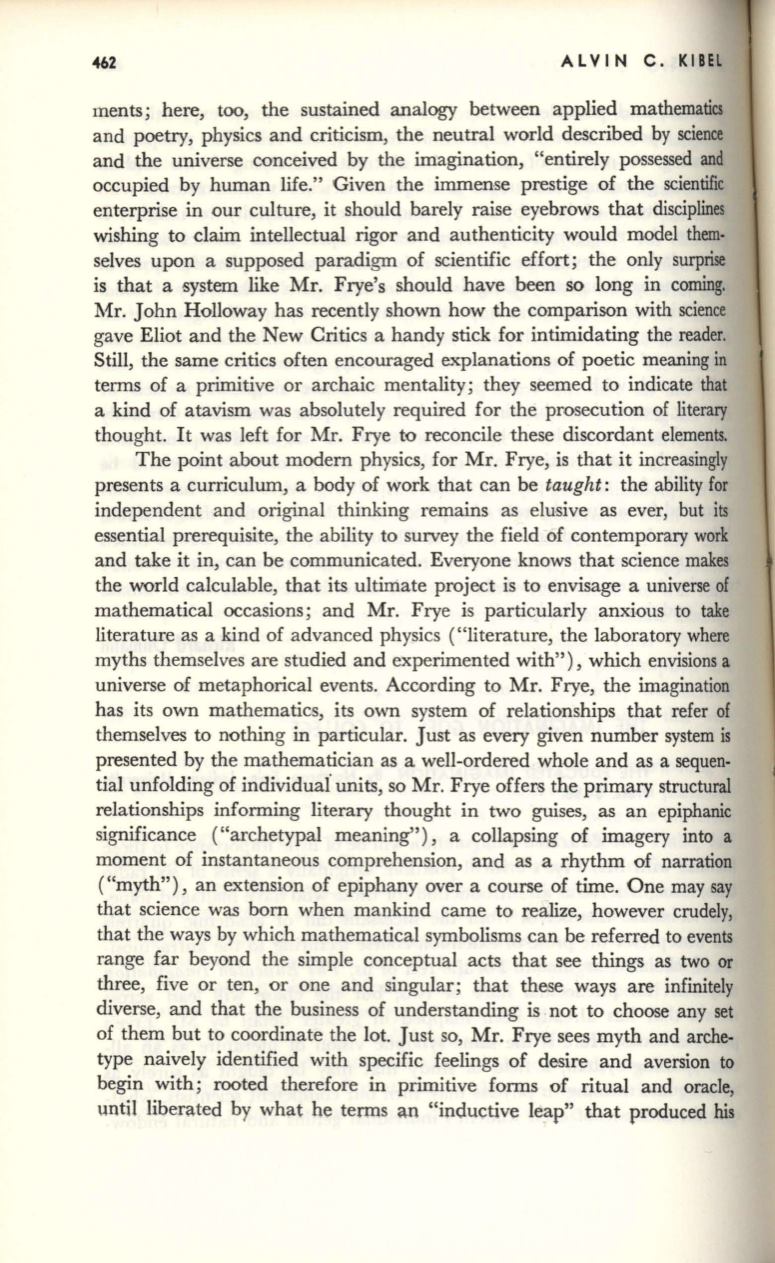
462
A LV INC. K
I BEL
ments; here, too, the sustained analogy between applied mathematics
and poetry, physics and criticism, the neutral world described by science
and the universe conceived by the imagination, "entirely possessed
and
occupied by human life." Given the immense prestige of the scientifiC
enterprise in our culture, it should barely raise eyebrows that disciplines
wishing to claim intellectual rigor and authenticity would model them·
selves upon a supposed paradigm of scientific effort; the only surprise
is that a system like Mr. Frye's should have been so long in coming.
Mr. John Holloway has recently shown how the comparison with science
gave Eliot and the New Critics a handy stick for intimidating the reader.
Still, the same critics often encouraged explanations of poetic meaning in
terms of a primitive or archaic mentality; they seemed to indicate that
a kind of atavism was absolutely required for the prosecution of literary
thought. It was left for Mr. Frye to reconcile these discordant elements.
The point about modern physics, for Mr. Frye, is that it increasingly
presents a curriculum, a body of work that can be
taught:
the ability for
independent and original thinking remains as elusive as ever, but its
essential prerequisite, the ability to survey the field of contemporary work
and take it in, can be communicated. Everyone knows that science makes
the world calculable, that its ultimate project is to envisage a universe of
mathematical occasions; and Mr. Frye is particularly anxious to take
literature as a kind of advanced physics ("literature, the laboratory where
myths themselves are studied and experimented with"), which envisions a
universe of metaphorical events. According to Mr. Frye, the imagination
has its own mathematics, its own system of relationships that refer of
themselves to nothing
in
particular. Just as every given number system
is
presented by the mathematician as a well-ordered whole and as a sequen–
tial unfolding of individual units, so Mr. Frye offers the primary structural
relationships informing literary thought in two guises, as an epiphanic
significance ("archetypal meaning"), a collapsing of imagery into a
moment of instantaneous comprehension, and as a rhythm of narration
("myth"), an extension of epiphany over a course of time. One may say
that science was born when mankind came to realize, however crudely,
that the ways by which mathematical symbolisms can be referred to events
range far beyond the simple conceptual acts that see things as two or
three, five or ten, or one and singular; that these ways are infinitely
diverse, and that the business of understanding is not to choose any set
of them but to coordinate the lot. Just so, Mr. Frye sees myth and arche–
type naively identified with specific feelings of desire and aversion to
begin with; rooted therefore in primitive forms of ritual and oracle,
until liberated by what he terms an "inductive leap" that produced
his


